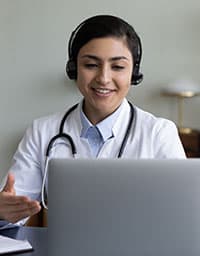
Overview of Telehealth
What is Telemedicine?
Telemedicine is a tool to extend the traditional practice of medicine outside the walls of a typical medical practice or hospital. Telemedicine is not a separate medical specialty but rather a mechanism to deliver safe, effective healthcare. Telemedicine uses technology to electronically exchange medical information and provide medical services to patients from a distance.
How is Telemedicine Different from Telehealth?
Telehealth often encompasses a broader definition of remote healthcare that doesn't always involve clinical services.
Both telemedicine and telehealth include:
- Videoconferencing
- Transmission of still images
- Remote monitoring of vital signs and other biometric data
- Nursing call centers
- E-health, including patient portals
- Continuing medical education
How Does Telemedicine Work?
Telemedicine can involve many different methods for providing healthcare remotely. Telemedicine connects small or rural community hospitals and outpatient locations to specialists, allowing patients to receive care close to home.
Some examples of clinical telemedicine services include:
- Videoconferencing between patients and healthcare providers
- Transmitting still images, via e-mail, electronic health record or other software, for interpretation by a physician in a remote location
- Remote monitoring of vital signs
- Electronic visits (e-mail between doctors and patients)
Some examples of clinical telemedicine services include:
- Emergent care, such as telestroke
- Real-time consultations with physicians and other healthcare providers, such as, tele-speech therapy
- Care Management
- Follow-up care
- Pre- and post-operative surgical care
Who Benefits from Telemedicine?
Both patients and healthcare providers located far from large cities or in rural areas can benefit greatly from telemedicine.
Patient benefits
- Reduces barriers to access
- Timely treatment close to home
- Reduced travel time
- Reduces overall healthcare costs
- Care Management
- Supports Improved quality
- Specialty consults to help make decisions about care
For healthcare providers, telemedicine provides:
- Educational opportunities and mentoring
- Increased efficiency
- Improved patient outcomes
- Reduced healthcare costs
- Increases patient satisfaction
For healthcare providers in rural areas or at small hospitals — telemedicine offers:
- Specialty consults to help make decisions about care
- Input from specialists without having to send patients to another facility
- Increased clinical quality
- Retains resources locally
Where to find specialty care?
- Hub and Spoke Model
- Consumer Specialty Care Model
What Equipment Do I Need for Telemedicine?
This depends on the specialty and the method of telemedicine transmission. Telemedicine generally uses a secure system with a high-speed internet connection and HIPAA-secure teleconferencing equipment.
Many hospitals throughout Utah already have store and forward image transfer capabilities and real-time videoconferencing systems that allow them to collaborate with specialists.
Videoconferencing - The clinical patient site uses a telemedicine practitioner’s cart, web-based videoconferencing platform, mobile phone, laptop/tablet or desktop computer at home, which includes the following:- Monitor
- Computer
- Webcam
There are many peripheral instruments which can be attached to the clinical practitioner's cart that can assist in an interactive examination. The National Telehealth Technology Assessment Resource Center (NTAC) releases assessments on various devices and are a valuable resource.
- Digital stethoscope
- Otoscope
- Ophthalmoscope
- Total exam camera
- Pluse oximeter
- Blood pressure cuff
- Digital thermometer
- Digital Glucometer
Store and forward technology — for obtaining and transmitting images to a remote site for review and consultation may require a software system on a personal computer and internet access.
Remote Monitoring – generally uses cellular technology &/or an internet connection to transmit vital signs and other bio-metric data to send to their healthcare provides. Patients may enter their vital signs manually or use blue-tooth technology to upload data.
Electronic visits (e-mail between doctors and patients) – internet access and a personal login.
Will Patients Still Need to See a Specialist in Person?
Possibly, but the ultimate goal of telemedicine is to allow patients to receive care close to home, rather than care that requires long-distance travel.
The resources presented on this website, and on the webpages accessible through the links on this page, are provided for informational purposes only. This information is not intended to be comprehensive and the manner in which it applies to your organization will be unique. You should seek expert advice to ensure that you are taking into account all relevant considerations. The UETN does not provide legal advice. If the resources that you find here do not answer your questions to your satisfaction, you should consult a lawyer or other qualified expert.




